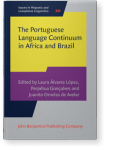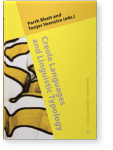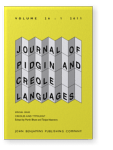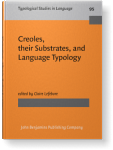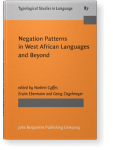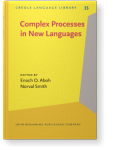Tjerk Hagemeijer
List of John Benjamins publications for which Tjerk Hagemeijer plays a role.
Journal
2018 Chapter 7. From creoles to Portuguese: Language shift in São Tomé and Príncipe The Portuguese Language Continuum in Africa and Brazil, Álvarez López, Laura, Perpétua Gonçalves and Juanito Ornelas de Avelar (eds.), pp. 169–184 | Chapter
The small island state of São Tomé and Príncipe, located in the Gulf of Guinea in West-Africa, is a linguistically unparalleled case in Africa in the sense that the former colonial language, Portuguese, has become the dominant native language of its population over time, replacing the historically… read more
2015 The Gulf of Guinea creoles: A case-study of syntactic reconstruction Perspectives on Historical Syntax, Viti, Carlotta (ed.), pp. 293–316 | Article
This paper argues that creole languages do not face some of the typical problems that have been discussed with respect to syntactic reconstruction of older languages. Creoles often belong to young language families and are therefore expected to show a significant amount of syntactic identity among… read more
2013 The Gulf of Guinea Creoles: Genetic and typological relations Creole Languages and Linguistic Typology, Bhatt, Parth and Tonjes Veenstra (eds.), pp. 163–206 | Article
Since Luis Ivens Ferraz’ work of the 1970s on the four Gulf of Guinea creoles, it has been generally accepted that we are dealing with closely related languages based on historical and linguistic data. However, Ferraz (1987: 348) considers that the Gulf of Guinea creoles share similarities because… read more
2011 The Gulf of Guinea Creoles: Genetic and typological relations Creoles and Typology, Bhatt, Parth and Tonjes Veenstra (eds.), pp. 111–154 | Article
Especially since Ferraz (1974, 1975, 1979), it has been generally accepted that the four Gulf of Guinea creoles (GGCs) — Santome (ST), Angolar (ANG), Lung’ie (LU), and Fa d’Ambô (FA)2 — are closely related languages based on historical and linguistic data. Ferraz shares his view on the type of… read more
2011 Èdó influence on Santome: Evidence from verb serialisation Creoles, their Substrates, and Language Typology, Lefebvre, Claire (ed.), pp. 37–60 | Article
Ferraz (1979) convincingly shows the impact of two typologically distinct African strata in the making of Santome: Èdó and Kikongo. In this paper, it will be shown that the extensive verb serialisation found in Santome shows a significant amount of typological overlap with Èdó multi-event and… read more
2009 Aspects of discontinuous negation in Santome Negation Patterns in West African Languages and Beyond, Cyffer, Norbert, Erwin Ebermann and Georg Ziegelmeyer (eds.), pp. 139–166 | Article
This paper provides an overview of the expression of negation in Santome, one of the
four Portuguese-based creole languages spoken in the Gulf of Guinea, focusing especially
on its standard discontinuous sentence negation pattern. It will be shown that the
distribution of the final… read more
2009 Initial vowel agglutination in the Gulf of Guinea creoles Complex Processes in New Languages, Aboh, Enoch O. and Norval Smith (eds.), pp. 29–50 | Article
The Gulf of Guinea creoles (GGCs) exhibit a number of cases of initial vowel agglutination to etymologically consonant-initial words in the lexifier, Portuguese. This property is especially common in Lung’ie (Principense). Comparing agglutinated items in the four GGCs not only sheds light on their… read more
2007 2. Bare nouns and the nominal domain in Santome Noun Phrases in Creole Languages: A multi-faceted approach, Baptista, Marlyse and Jacqueline Guéron (eds.), pp. 37–59 | Chapter
This paper investigates the role of BNPs within the nominal system of Santome, the major Gulf of Guinea Creole. In the first part of the paper, we sketch an analysis of the DP focusing on the syntax and semantics of the modifiers that express definiteness, number and specificity and their… read more


